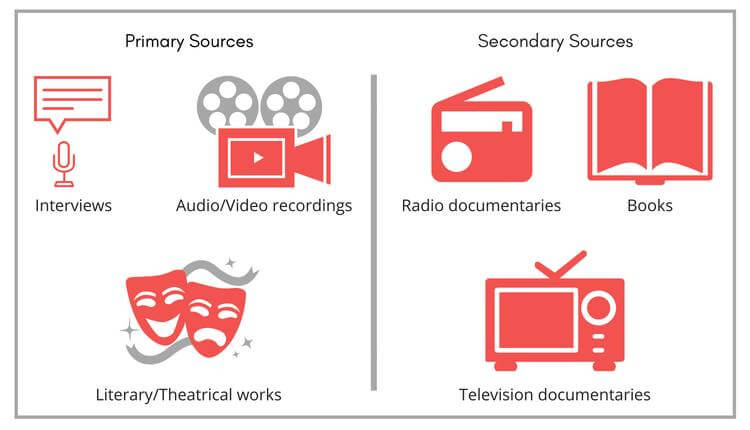Primary Vs. Secondary Sources — Understanding the difference to avoid incorrect citations

When writing an academic paper, citing your sources is the most important aspect. Academic sources are scholarly books, articles, and research papers that are peer-reviewed, credible, and authoritative. However, there is confusion among researchers in understanding what literature counts as a source and which type of source to use?
This blog will help researchers understand the difference between types of sources and explain when each should be used.
Primary Vs. Secondary Sources
Primary and secondary sources assist researchers through their literature study. To use sources efficiently and in the correct manner, one must identify the nature of each source and the reason for using it. This will help researchers distinguish between their contribution and the argument expressed by the sources used.
The primary sources provide direct evidence of a topic. Meanwhile, secondary sources are the analyses based on existing primary source. For example, if one were researching the American Civil War, the primary source would be a letter written by a soldier who fought in the war, while a secondary source would be a history book about the war.
While writing a research paper, it is essential to use both primary and secondary sources to understand the nitty-gritty of a topic.
What Is a Primary Source?
A primary source is a first-hand record of an event. These are the events or evidence that were first described without any interpretation or commentary. This source gives researchers direct access to the subject of research and displays original thinking, reports on discoveries, or shares new information.
Examples of Primary Sources
Theses, dissertations, scholarly journal articles (research-based), government reports, symposia and conference proceedings, original artwork, poems, photographs, speeches, letters, memos, personal narratives, diaries, interviews, autobiographies, and correspondence.
What Is a Secondary Source?
A secondary source offers an analysis or restatement of a primary source. These provide second-hand information and commentary from based on the original sources. These majorly include peer-reviewed academic sources, such as journal articles, books, and book chapters for research.
Examples of Secondary Sources
Textbooks, edited works, books, and articles that interpret or review research works, histories, biographies, literary criticism, and interpretation, reviews of law and legislation, political analyses, and commentaries.
The table below shows some differences between both types of sources.
|
Primary Sources
|
Secondary Sources
|
| Primary sources are original documents that provide first-hand records. For example, diaries, artwork, poems, letters, journals, treaties, and speeches are all primary sources. | Secondary sources are interpretations of primary sources. For example, they can be articles, television documentaries, conferences, biographies, essays, and critiques of a piece of art. |
| These are written by experienced people who are directly involved in the research study. Professors, historians, and scientists in specific fields may write these. | These are written by researchers or writers seeking information while conducting and reporting research using primary sources. |
Deciding Between Primary and Secondary Sources
Deciding and identifying between primary and secondary sources is difficult. Researchers often experience this situation while composing research papers, assignments, or journal articles. Finding the right source is the most important factor while citing information. A researcher must know which is the best source (primary or secondary source) for their research project. Following are some points that will assist researchers in understanding and distinguishing between primary and secondary sources —
- The primary sources include works by individuals commenting on a theory or event.
- The secondary sources are often pieces of writing that elaborate on the source.
- The primary sources comprise original research work initiated by scientists.
- For secondary sources, the information obtained from the primary sources forms the baseline of the content.
- The primary sources comprise data obtained from surveys, census, economic statistics, or other datasets that have not been recorded earlier.
- The secondary sources also contain such data and are referenced to the original primary sources.
- Secondary sources are mostly scholarly. A source is considered scholarly when the authors are not directly involved in gathering the original information.
- Secondary sources could be a compilation of information from different primary sources.
Apart from understanding the difference between primary and secondary sources, a crucial aspect of sources is to determine their credibility before citing them. Researchers must do a thorough check of the sources they wish to cite in their research study. This will help them avoid the inclusion of false information in articles, research papers, journals, or writing assignments.
Secondary Sources Citation
Some of the popular secondary source citation formats include the MLA (Modern Language Assoication) style guide, the APA (American Psychology Association) style guide, and the Chicago Manual of Style (CMOS). These citation styles enable writers to correctly cite information obtained from various sources.
In MLA style, the citations consist of two parts: a brief in-text citation in the body of the essay and a detailed list of the “Works Cited” at the end of the work. In MLA style citation, the elements are listed in the following order: author, title of source, the title of container, other contributors, Version, Number, Publisher, Publication Date, and Location.
The APA referencing style is an author-date style. The citation in the text consists of the author(s) and the year of publication given either wholly or partly in parentheses. In APA style citation, use only the surname of the author(s) followed by a comma and the year of publication. Include the page, chapter, or section numbers if you need to be specific. There is no distinction between books, journal articles, internet documents, or other formats except for electronic documents that do not provide page numbers
The CMOS provides guidelines for two styles of citation: author-date and notes and bibliography —
- In the author-date style (mostly used in sciences), researchers use brief parenthetical references to cite sources in the text.
- In notes and bibliography style (mostly used in the humanities), researchers use footnotes or endnotes to cite sources.
In conclusion, it is essential for early career researchers to understand the differences between primary and secondary sources before they start their research journey. Research papers based on incorrect citations can be rejected outright. The best way to learn about primary and secondary sources is to consult a professor or a senior in your field of study. Once you have understood the concept, it will be easier for you to identify primary and secondary sources when you come across them.
When in doubt, always cite the source from which you have taken the information. If you need help with understanding MLA, APA or CMOS style referencing, please visit: https://www.enago.com/plagiarism-checker/citation-generator/











Good one to understand differences.
Helpful for a quick reference on the definition and differences of primary and secondary research sources.
good place for information
good place for information
it is a good refresher
Helpful enough.